Contempt of Court by Publication: Tension Between Fair Trial and Freedom of Expression
VerifiedAdded on 2022/12/23
|11
|4115
|1
AI Summary
This article explores the tension between the right to a fair trial and the right to freedom of expression in cases of contempt of court by publication. It discusses the legislation, cases, and treaties related to this issue and examines the effectiveness of the law in protecting both rights.
Contribute Materials
Your contribution can guide someone’s learning journey. Share your
documents today.
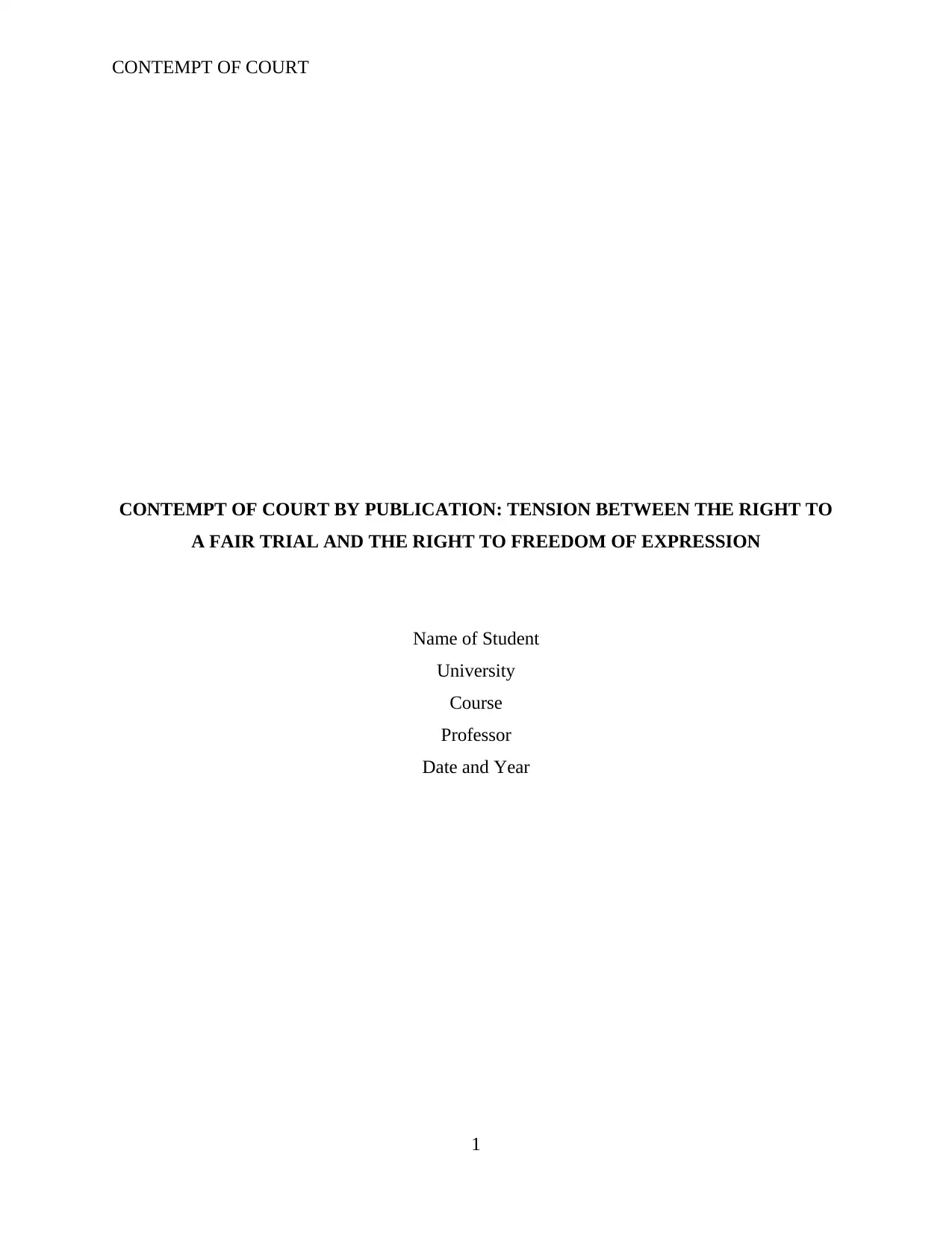
CONTEMPT OF COURT
CONTEMPT OF COURT BY PUBLICATION: TENSION BETWEEN THE RIGHT TO
A FAIR TRIAL AND THE RIGHT TO FREEDOM OF EXPRESSION
Name of Student
University
Course
Professor
Date and Year
1
CONTEMPT OF COURT BY PUBLICATION: TENSION BETWEEN THE RIGHT TO
A FAIR TRIAL AND THE RIGHT TO FREEDOM OF EXPRESSION
Name of Student
University
Course
Professor
Date and Year
1
Secure Best Marks with AI Grader
Need help grading? Try our AI Grader for instant feedback on your assignments.
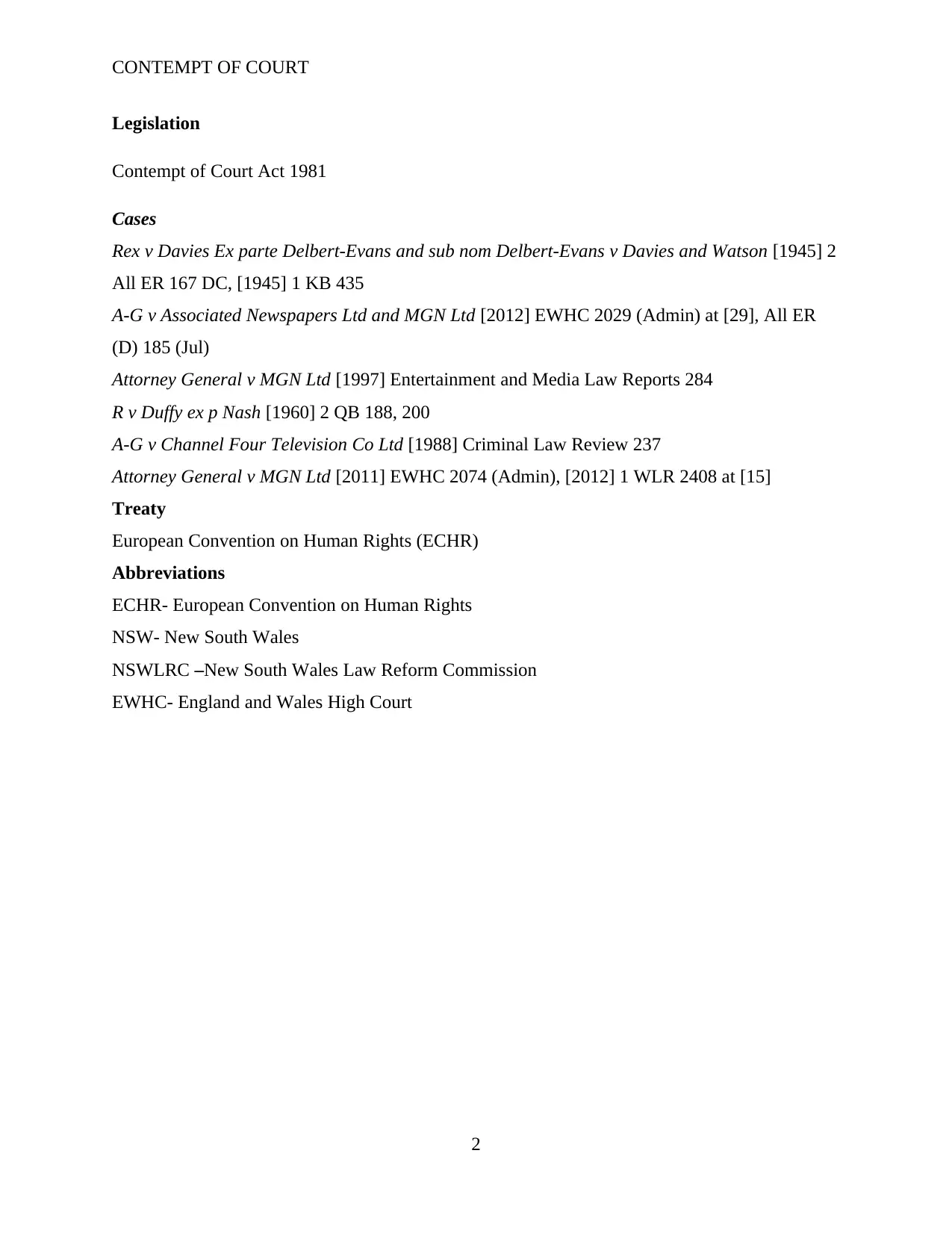
CONTEMPT OF COURT
Legislation
Contempt of Court Act 1981
Cases
Rex v Davies Ex parte Delbert-Evans and sub nom Delbert-Evans v Davies and Watson [1945] 2
All ER 167 DC, [1945] 1 KB 435
A-G v Associated Newspapers Ltd and MGN Ltd [2012] EWHC 2029 (Admin) at [29], All ER
(D) 185 (Jul)
Attorney General v MGN Ltd [1997] Entertainment and Media Law Reports 284
R v Duffy ex p Nash [1960] 2 QB 188, 200
A-G v Channel Four Television Co Ltd [1988] Criminal Law Review 237
Attorney General v MGN Ltd [2011] EWHC 2074 (Admin), [2012] 1 WLR 2408 at [15]
Treaty
European Convention on Human Rights (ECHR)
Abbreviations
ECHR- European Convention on Human Rights
NSW- New South Wales
NSWLRC –New South Wales Law Reform Commission
EWHC- England and Wales High Court
2
Legislation
Contempt of Court Act 1981
Cases
Rex v Davies Ex parte Delbert-Evans and sub nom Delbert-Evans v Davies and Watson [1945] 2
All ER 167 DC, [1945] 1 KB 435
A-G v Associated Newspapers Ltd and MGN Ltd [2012] EWHC 2029 (Admin) at [29], All ER
(D) 185 (Jul)
Attorney General v MGN Ltd [1997] Entertainment and Media Law Reports 284
R v Duffy ex p Nash [1960] 2 QB 188, 200
A-G v Channel Four Television Co Ltd [1988] Criminal Law Review 237
Attorney General v MGN Ltd [2011] EWHC 2074 (Admin), [2012] 1 WLR 2408 at [15]
Treaty
European Convention on Human Rights (ECHR)
Abbreviations
ECHR- European Convention on Human Rights
NSW- New South Wales
NSWLRC –New South Wales Law Reform Commission
EWHC- England and Wales High Court
2
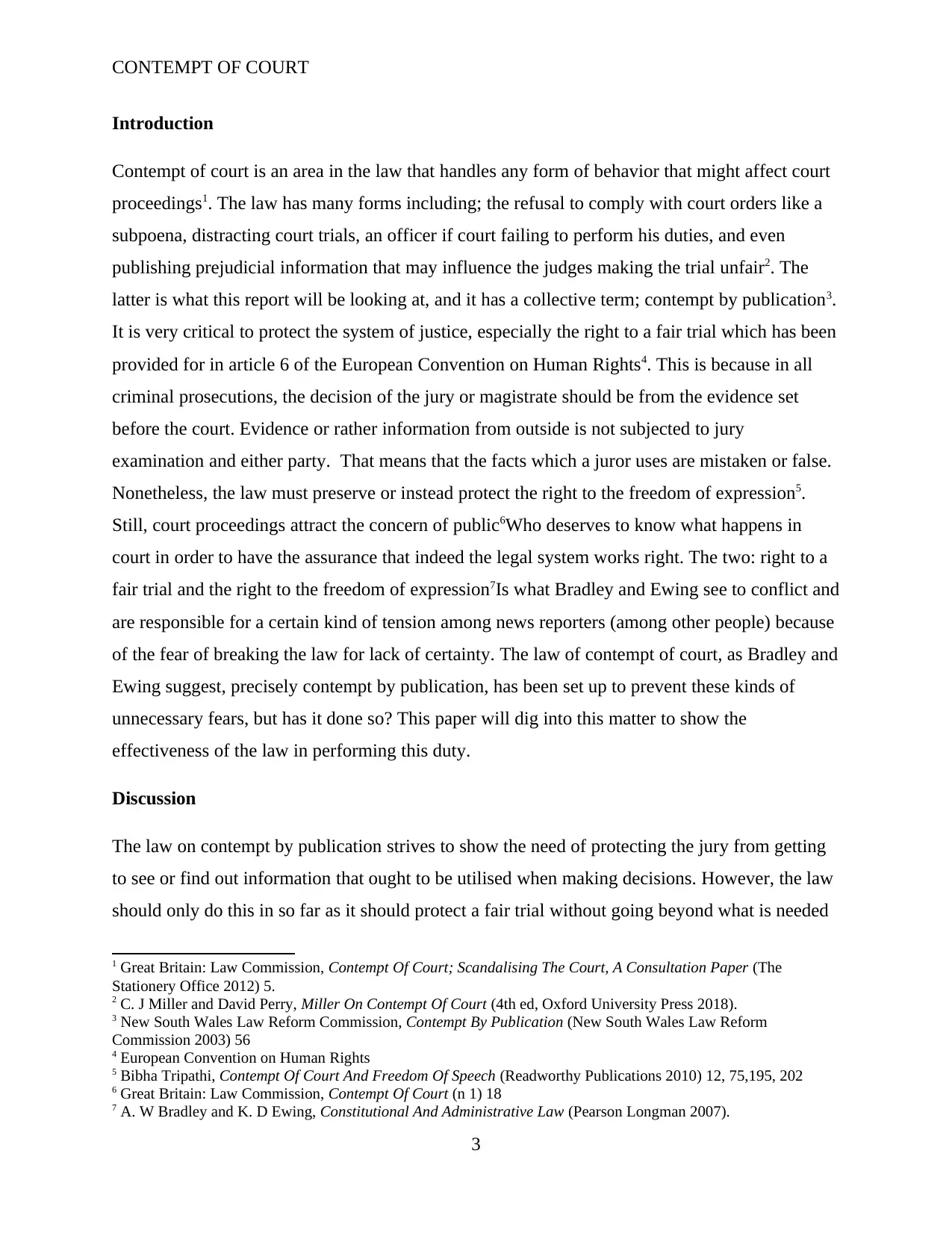
CONTEMPT OF COURT
Introduction
Contempt of court is an area in the law that handles any form of behavior that might affect court
proceedings1. The law has many forms including; the refusal to comply with court orders like a
subpoena, distracting court trials, an officer if court failing to perform his duties, and even
publishing prejudicial information that may influence the judges making the trial unfair2. The
latter is what this report will be looking at, and it has a collective term; contempt by publication3.
It is very critical to protect the system of justice, especially the right to a fair trial which has been
provided for in article 6 of the European Convention on Human Rights4. This is because in all
criminal prosecutions, the decision of the jury or magistrate should be from the evidence set
before the court. Evidence or rather information from outside is not subjected to jury
examination and either party. That means that the facts which a juror uses are mistaken or false.
Nonetheless, the law must preserve or instead protect the right to the freedom of expression5.
Still, court proceedings attract the concern of public6Who deserves to know what happens in
court in order to have the assurance that indeed the legal system works right. The two: right to a
fair trial and the right to the freedom of expression7Is what Bradley and Ewing see to conflict and
are responsible for a certain kind of tension among news reporters (among other people) because
of the fear of breaking the law for lack of certainty. The law of contempt of court, as Bradley and
Ewing suggest, precisely contempt by publication, has been set up to prevent these kinds of
unnecessary fears, but has it done so? This paper will dig into this matter to show the
effectiveness of the law in performing this duty.
Discussion
The law on contempt by publication strives to show the need of protecting the jury from getting
to see or find out information that ought to be utilised when making decisions. However, the law
should only do this in so far as it should protect a fair trial without going beyond what is needed
1 Great Britain: Law Commission, Contempt Of Court; Scandalising The Court, A Consultation Paper (The
Stationery Office 2012) 5.
2 C. J Miller and David Perry, Miller On Contempt Of Court (4th ed, Oxford University Press 2018).
3 New South Wales Law Reform Commission, Contempt By Publication (New South Wales Law Reform
Commission 2003) 56
4 European Convention on Human Rights
5 Bibha Tripathi, Contempt Of Court And Freedom Of Speech (Readworthy Publications 2010) 12, 75,195, 202
6 Great Britain: Law Commission, Contempt Of Court (n 1) 18
7 A. W Bradley and K. D Ewing, Constitutional And Administrative Law (Pearson Longman 2007).
3
Introduction
Contempt of court is an area in the law that handles any form of behavior that might affect court
proceedings1. The law has many forms including; the refusal to comply with court orders like a
subpoena, distracting court trials, an officer if court failing to perform his duties, and even
publishing prejudicial information that may influence the judges making the trial unfair2. The
latter is what this report will be looking at, and it has a collective term; contempt by publication3.
It is very critical to protect the system of justice, especially the right to a fair trial which has been
provided for in article 6 of the European Convention on Human Rights4. This is because in all
criminal prosecutions, the decision of the jury or magistrate should be from the evidence set
before the court. Evidence or rather information from outside is not subjected to jury
examination and either party. That means that the facts which a juror uses are mistaken or false.
Nonetheless, the law must preserve or instead protect the right to the freedom of expression5.
Still, court proceedings attract the concern of public6Who deserves to know what happens in
court in order to have the assurance that indeed the legal system works right. The two: right to a
fair trial and the right to the freedom of expression7Is what Bradley and Ewing see to conflict and
are responsible for a certain kind of tension among news reporters (among other people) because
of the fear of breaking the law for lack of certainty. The law of contempt of court, as Bradley and
Ewing suggest, precisely contempt by publication, has been set up to prevent these kinds of
unnecessary fears, but has it done so? This paper will dig into this matter to show the
effectiveness of the law in performing this duty.
Discussion
The law on contempt by publication strives to show the need of protecting the jury from getting
to see or find out information that ought to be utilised when making decisions. However, the law
should only do this in so far as it should protect a fair trial without going beyond what is needed
1 Great Britain: Law Commission, Contempt Of Court; Scandalising The Court, A Consultation Paper (The
Stationery Office 2012) 5.
2 C. J Miller and David Perry, Miller On Contempt Of Court (4th ed, Oxford University Press 2018).
3 New South Wales Law Reform Commission, Contempt By Publication (New South Wales Law Reform
Commission 2003) 56
4 European Convention on Human Rights
5 Bibha Tripathi, Contempt Of Court And Freedom Of Speech (Readworthy Publications 2010) 12, 75,195, 202
6 Great Britain: Law Commission, Contempt Of Court (n 1) 18
7 A. W Bradley and K. D Ewing, Constitutional And Administrative Law (Pearson Longman 2007).
3
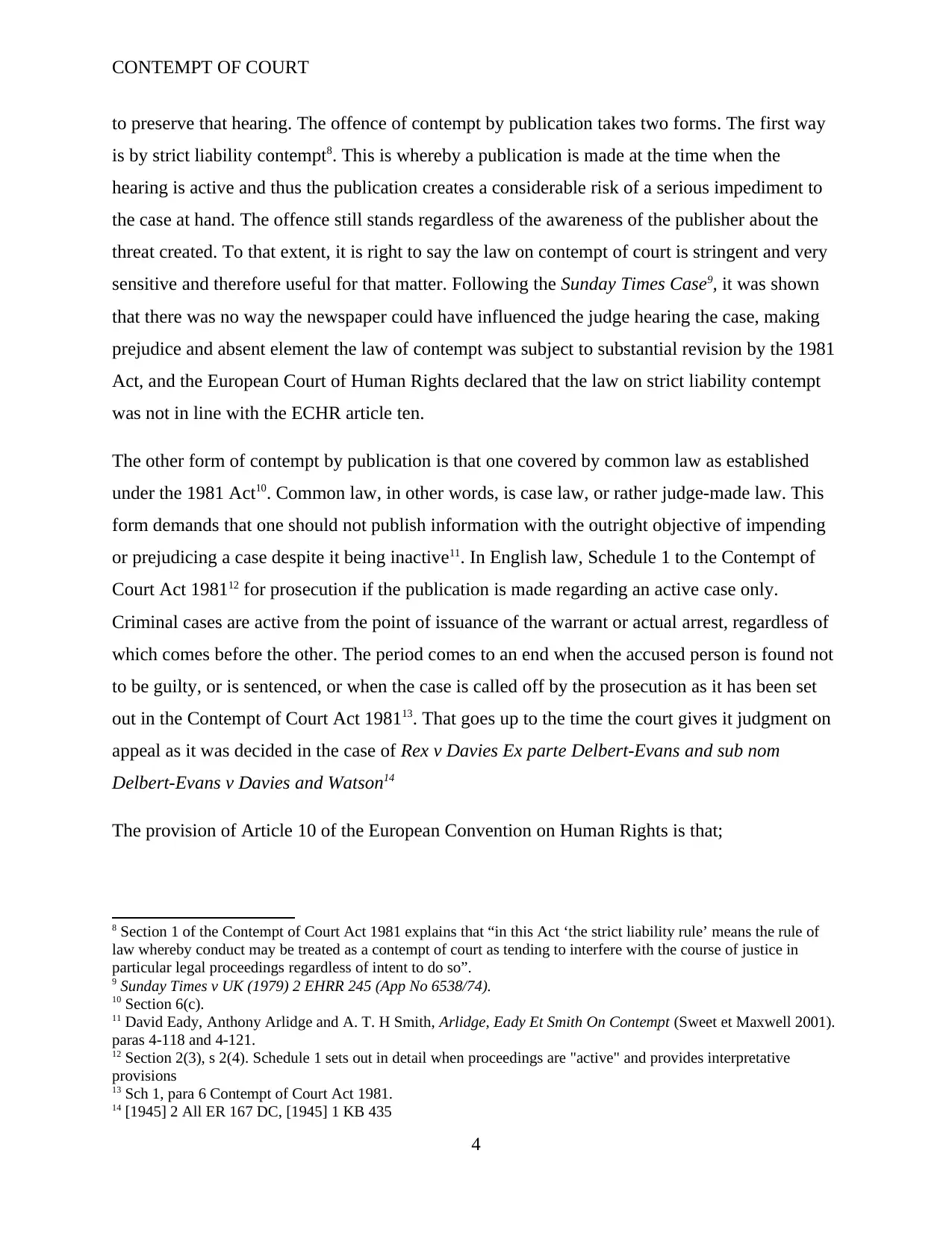
CONTEMPT OF COURT
to preserve that hearing. The offence of contempt by publication takes two forms. The first way
is by strict liability contempt8. This is whereby a publication is made at the time when the
hearing is active and thus the publication creates a considerable risk of a serious impediment to
the case at hand. The offence still stands regardless of the awareness of the publisher about the
threat created. To that extent, it is right to say the law on contempt of court is stringent and very
sensitive and therefore useful for that matter. Following the Sunday Times Case9, it was shown
that there was no way the newspaper could have influenced the judge hearing the case, making
prejudice and absent element the law of contempt was subject to substantial revision by the 1981
Act, and the European Court of Human Rights declared that the law on strict liability contempt
was not in line with the ECHR article ten.
The other form of contempt by publication is that one covered by common law as established
under the 1981 Act10. Common law, in other words, is case law, or rather judge-made law. This
form demands that one should not publish information with the outright objective of impending
or prejudicing a case despite it being inactive11. In English law, Schedule 1 to the Contempt of
Court Act 198112 for prosecution if the publication is made regarding an active case only.
Criminal cases are active from the point of issuance of the warrant or actual arrest, regardless of
which comes before the other. The period comes to an end when the accused person is found not
to be guilty, or is sentenced, or when the case is called off by the prosecution as it has been set
out in the Contempt of Court Act 198113. That goes up to the time the court gives it judgment on
appeal as it was decided in the case of Rex v Davies Ex parte Delbert-Evans and sub nom
Delbert-Evans v Davies and Watson14
The provision of Article 10 of the European Convention on Human Rights is that;
8 Section 1 of the Contempt of Court Act 1981 explains that “in this Act ‘the strict liability rule’ means the rule of
law whereby conduct may be treated as a contempt of court as tending to interfere with the course of justice in
particular legal proceedings regardless of intent to do so”.
9 Sunday Times v UK (1979) 2 EHRR 245 (App No 6538/74).
10 Section 6(c).
11 David Eady, Anthony Arlidge and A. T. H Smith, Arlidge, Eady Et Smith On Contempt (Sweet et Maxwell 2001).
paras 4-118 and 4-121.
12 Section 2(3), s 2(4). Schedule 1 sets out in detail when proceedings are "active" and provides interpretative
provisions
13 Sch 1, para 6 Contempt of Court Act 1981.
14 [1945] 2 All ER 167 DC, [1945] 1 KB 435
4
to preserve that hearing. The offence of contempt by publication takes two forms. The first way
is by strict liability contempt8. This is whereby a publication is made at the time when the
hearing is active and thus the publication creates a considerable risk of a serious impediment to
the case at hand. The offence still stands regardless of the awareness of the publisher about the
threat created. To that extent, it is right to say the law on contempt of court is stringent and very
sensitive and therefore useful for that matter. Following the Sunday Times Case9, it was shown
that there was no way the newspaper could have influenced the judge hearing the case, making
prejudice and absent element the law of contempt was subject to substantial revision by the 1981
Act, and the European Court of Human Rights declared that the law on strict liability contempt
was not in line with the ECHR article ten.
The other form of contempt by publication is that one covered by common law as established
under the 1981 Act10. Common law, in other words, is case law, or rather judge-made law. This
form demands that one should not publish information with the outright objective of impending
or prejudicing a case despite it being inactive11. In English law, Schedule 1 to the Contempt of
Court Act 198112 for prosecution if the publication is made regarding an active case only.
Criminal cases are active from the point of issuance of the warrant or actual arrest, regardless of
which comes before the other. The period comes to an end when the accused person is found not
to be guilty, or is sentenced, or when the case is called off by the prosecution as it has been set
out in the Contempt of Court Act 198113. That goes up to the time the court gives it judgment on
appeal as it was decided in the case of Rex v Davies Ex parte Delbert-Evans and sub nom
Delbert-Evans v Davies and Watson14
The provision of Article 10 of the European Convention on Human Rights is that;
8 Section 1 of the Contempt of Court Act 1981 explains that “in this Act ‘the strict liability rule’ means the rule of
law whereby conduct may be treated as a contempt of court as tending to interfere with the course of justice in
particular legal proceedings regardless of intent to do so”.
9 Sunday Times v UK (1979) 2 EHRR 245 (App No 6538/74).
10 Section 6(c).
11 David Eady, Anthony Arlidge and A. T. H Smith, Arlidge, Eady Et Smith On Contempt (Sweet et Maxwell 2001).
paras 4-118 and 4-121.
12 Section 2(3), s 2(4). Schedule 1 sets out in detail when proceedings are "active" and provides interpretative
provisions
13 Sch 1, para 6 Contempt of Court Act 1981.
14 [1945] 2 All ER 167 DC, [1945] 1 KB 435
4
Secure Best Marks with AI Grader
Need help grading? Try our AI Grader for instant feedback on your assignments.
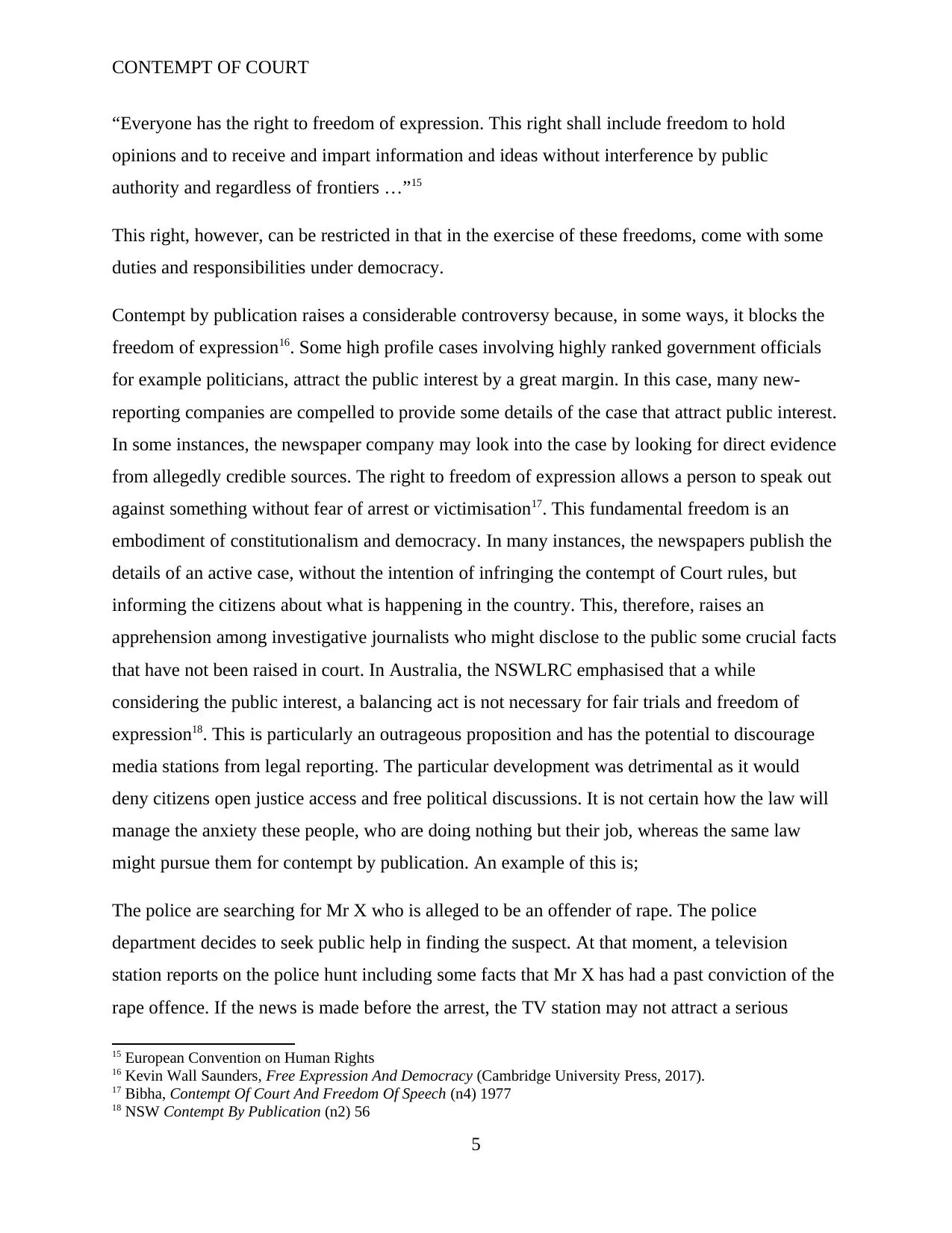
CONTEMPT OF COURT
“Everyone has the right to freedom of expression. This right shall include freedom to hold
opinions and to receive and impart information and ideas without interference by public
authority and regardless of frontiers …”15
This right, however, can be restricted in that in the exercise of these freedoms, come with some
duties and responsibilities under democracy.
Contempt by publication raises a considerable controversy because, in some ways, it blocks the
freedom of expression16. Some high profile cases involving highly ranked government officials
for example politicians, attract the public interest by a great margin. In this case, many new-
reporting companies are compelled to provide some details of the case that attract public interest.
In some instances, the newspaper company may look into the case by looking for direct evidence
from allegedly credible sources. The right to freedom of expression allows a person to speak out
against something without fear of arrest or victimisation17. This fundamental freedom is an
embodiment of constitutionalism and democracy. In many instances, the newspapers publish the
details of an active case, without the intention of infringing the contempt of Court rules, but
informing the citizens about what is happening in the country. This, therefore, raises an
apprehension among investigative journalists who might disclose to the public some crucial facts
that have not been raised in court. In Australia, the NSWLRC emphasised that a while
considering the public interest, a balancing act is not necessary for fair trials and freedom of
expression18. This is particularly an outrageous proposition and has the potential to discourage
media stations from legal reporting. The particular development was detrimental as it would
deny citizens open justice access and free political discussions. It is not certain how the law will
manage the anxiety these people, who are doing nothing but their job, whereas the same law
might pursue them for contempt by publication. An example of this is;
The police are searching for Mr X who is alleged to be an offender of rape. The police
department decides to seek public help in finding the suspect. At that moment, a television
station reports on the police hunt including some facts that Mr X has had a past conviction of the
rape offence. If the news is made before the arrest, the TV station may not attract a serious
15 European Convention on Human Rights
16 Kevin Wall Saunders, Free Expression And Democracy (Cambridge University Press, 2017).
17 Bibha, Contempt Of Court And Freedom Of Speech (n4) 1977
18 NSW Contempt By Publication (n2) 56
5
“Everyone has the right to freedom of expression. This right shall include freedom to hold
opinions and to receive and impart information and ideas without interference by public
authority and regardless of frontiers …”15
This right, however, can be restricted in that in the exercise of these freedoms, come with some
duties and responsibilities under democracy.
Contempt by publication raises a considerable controversy because, in some ways, it blocks the
freedom of expression16. Some high profile cases involving highly ranked government officials
for example politicians, attract the public interest by a great margin. In this case, many new-
reporting companies are compelled to provide some details of the case that attract public interest.
In some instances, the newspaper company may look into the case by looking for direct evidence
from allegedly credible sources. The right to freedom of expression allows a person to speak out
against something without fear of arrest or victimisation17. This fundamental freedom is an
embodiment of constitutionalism and democracy. In many instances, the newspapers publish the
details of an active case, without the intention of infringing the contempt of Court rules, but
informing the citizens about what is happening in the country. This, therefore, raises an
apprehension among investigative journalists who might disclose to the public some crucial facts
that have not been raised in court. In Australia, the NSWLRC emphasised that a while
considering the public interest, a balancing act is not necessary for fair trials and freedom of
expression18. This is particularly an outrageous proposition and has the potential to discourage
media stations from legal reporting. The particular development was detrimental as it would
deny citizens open justice access and free political discussions. It is not certain how the law will
manage the anxiety these people, who are doing nothing but their job, whereas the same law
might pursue them for contempt by publication. An example of this is;
The police are searching for Mr X who is alleged to be an offender of rape. The police
department decides to seek public help in finding the suspect. At that moment, a television
station reports on the police hunt including some facts that Mr X has had a past conviction of the
rape offence. If the news is made before the arrest, the TV station may not attract a serious
15 European Convention on Human Rights
16 Kevin Wall Saunders, Free Expression And Democracy (Cambridge University Press, 2017).
17 Bibha, Contempt Of Court And Freedom Of Speech (n4) 1977
18 NSW Contempt By Publication (n2) 56
5
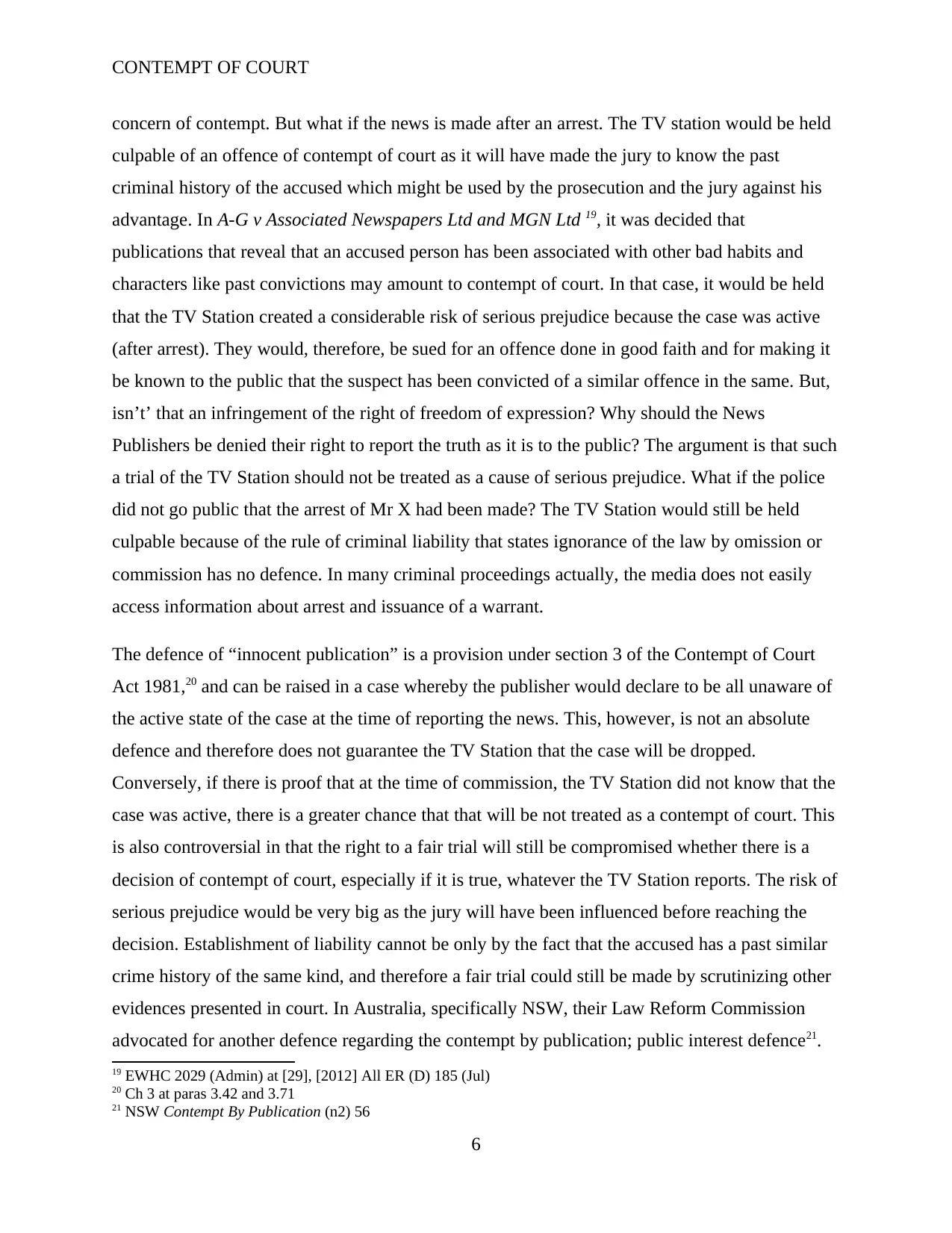
CONTEMPT OF COURT
concern of contempt. But what if the news is made after an arrest. The TV station would be held
culpable of an offence of contempt of court as it will have made the jury to know the past
criminal history of the accused which might be used by the prosecution and the jury against his
advantage. In A-G v Associated Newspapers Ltd and MGN Ltd 19, it was decided that
publications that reveal that an accused person has been associated with other bad habits and
characters like past convictions may amount to contempt of court. In that case, it would be held
that the TV Station created a considerable risk of serious prejudice because the case was active
(after arrest). They would, therefore, be sued for an offence done in good faith and for making it
be known to the public that the suspect has been convicted of a similar offence in the same. But,
isn’t’ that an infringement of the right of freedom of expression? Why should the News
Publishers be denied their right to report the truth as it is to the public? The argument is that such
a trial of the TV Station should not be treated as a cause of serious prejudice. What if the police
did not go public that the arrest of Mr X had been made? The TV Station would still be held
culpable because of the rule of criminal liability that states ignorance of the law by omission or
commission has no defence. In many criminal proceedings actually, the media does not easily
access information about arrest and issuance of a warrant.
The defence of “innocent publication” is a provision under section 3 of the Contempt of Court
Act 1981,20 and can be raised in a case whereby the publisher would declare to be all unaware of
the active state of the case at the time of reporting the news. This, however, is not an absolute
defence and therefore does not guarantee the TV Station that the case will be dropped.
Conversely, if there is proof that at the time of commission, the TV Station did not know that the
case was active, there is a greater chance that that will be not treated as a contempt of court. This
is also controversial in that the right to a fair trial will still be compromised whether there is a
decision of contempt of court, especially if it is true, whatever the TV Station reports. The risk of
serious prejudice would be very big as the jury will have been influenced before reaching the
decision. Establishment of liability cannot be only by the fact that the accused has a past similar
crime history of the same kind, and therefore a fair trial could still be made by scrutinizing other
evidences presented in court. In Australia, specifically NSW, their Law Reform Commission
advocated for another defence regarding the contempt by publication; public interest defence21.
19 EWHC 2029 (Admin) at [29], [2012] All ER (D) 185 (Jul)
20 Ch 3 at paras 3.42 and 3.71
21 NSW Contempt By Publication (n2) 56
6
concern of contempt. But what if the news is made after an arrest. The TV station would be held
culpable of an offence of contempt of court as it will have made the jury to know the past
criminal history of the accused which might be used by the prosecution and the jury against his
advantage. In A-G v Associated Newspapers Ltd and MGN Ltd 19, it was decided that
publications that reveal that an accused person has been associated with other bad habits and
characters like past convictions may amount to contempt of court. In that case, it would be held
that the TV Station created a considerable risk of serious prejudice because the case was active
(after arrest). They would, therefore, be sued for an offence done in good faith and for making it
be known to the public that the suspect has been convicted of a similar offence in the same. But,
isn’t’ that an infringement of the right of freedom of expression? Why should the News
Publishers be denied their right to report the truth as it is to the public? The argument is that such
a trial of the TV Station should not be treated as a cause of serious prejudice. What if the police
did not go public that the arrest of Mr X had been made? The TV Station would still be held
culpable because of the rule of criminal liability that states ignorance of the law by omission or
commission has no defence. In many criminal proceedings actually, the media does not easily
access information about arrest and issuance of a warrant.
The defence of “innocent publication” is a provision under section 3 of the Contempt of Court
Act 1981,20 and can be raised in a case whereby the publisher would declare to be all unaware of
the active state of the case at the time of reporting the news. This, however, is not an absolute
defence and therefore does not guarantee the TV Station that the case will be dropped.
Conversely, if there is proof that at the time of commission, the TV Station did not know that the
case was active, there is a greater chance that that will be not treated as a contempt of court. This
is also controversial in that the right to a fair trial will still be compromised whether there is a
decision of contempt of court, especially if it is true, whatever the TV Station reports. The risk of
serious prejudice would be very big as the jury will have been influenced before reaching the
decision. Establishment of liability cannot be only by the fact that the accused has a past similar
crime history of the same kind, and therefore a fair trial could still be made by scrutinizing other
evidences presented in court. In Australia, specifically NSW, their Law Reform Commission
advocated for another defence regarding the contempt by publication; public interest defence21.
19 EWHC 2029 (Admin) at [29], [2012] All ER (D) 185 (Jul)
20 Ch 3 at paras 3.42 and 3.71
21 NSW Contempt By Publication (n2) 56
6
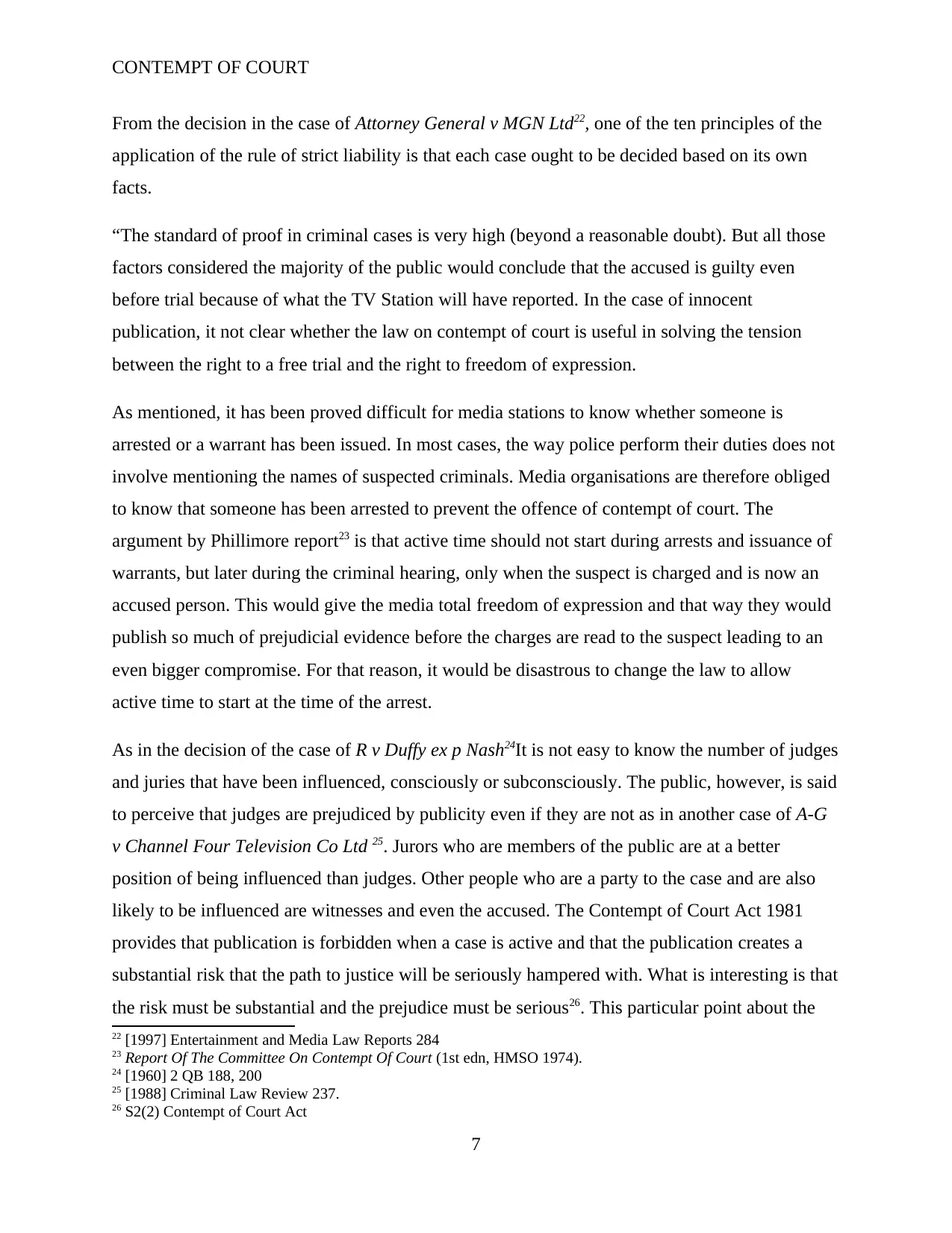
CONTEMPT OF COURT
From the decision in the case of Attorney General v MGN Ltd22, one of the ten principles of the
application of the rule of strict liability is that each case ought to be decided based on its own
facts.
“The standard of proof in criminal cases is very high (beyond a reasonable doubt). But all those
factors considered the majority of the public would conclude that the accused is guilty even
before trial because of what the TV Station will have reported. In the case of innocent
publication, it not clear whether the law on contempt of court is useful in solving the tension
between the right to a free trial and the right to freedom of expression.
As mentioned, it has been proved difficult for media stations to know whether someone is
arrested or a warrant has been issued. In most cases, the way police perform their duties does not
involve mentioning the names of suspected criminals. Media organisations are therefore obliged
to know that someone has been arrested to prevent the offence of contempt of court. The
argument by Phillimore report23 is that active time should not start during arrests and issuance of
warrants, but later during the criminal hearing, only when the suspect is charged and is now an
accused person. This would give the media total freedom of expression and that way they would
publish so much of prejudicial evidence before the charges are read to the suspect leading to an
even bigger compromise. For that reason, it would be disastrous to change the law to allow
active time to start at the time of the arrest.
As in the decision of the case of R v Duffy ex p Nash24It is not easy to know the number of judges
and juries that have been influenced, consciously or subconsciously. The public, however, is said
to perceive that judges are prejudiced by publicity even if they are not as in another case of A-G
v Channel Four Television Co Ltd 25. Jurors who are members of the public are at a better
position of being influenced than judges. Other people who are a party to the case and are also
likely to be influenced are witnesses and even the accused. The Contempt of Court Act 1981
provides that publication is forbidden when a case is active and that the publication creates a
substantial risk that the path to justice will be seriously hampered with. What is interesting is that
the risk must be substantial and the prejudice must be serious26. This particular point about the
22 [1997] Entertainment and Media Law Reports 284
23 Report Of The Committee On Contempt Of Court (1st edn, HMSO 1974).
24 [1960] 2 QB 188, 200
25 [1988] Criminal Law Review 237.
26 S2(2) Contempt of Court Act
7
From the decision in the case of Attorney General v MGN Ltd22, one of the ten principles of the
application of the rule of strict liability is that each case ought to be decided based on its own
facts.
“The standard of proof in criminal cases is very high (beyond a reasonable doubt). But all those
factors considered the majority of the public would conclude that the accused is guilty even
before trial because of what the TV Station will have reported. In the case of innocent
publication, it not clear whether the law on contempt of court is useful in solving the tension
between the right to a free trial and the right to freedom of expression.
As mentioned, it has been proved difficult for media stations to know whether someone is
arrested or a warrant has been issued. In most cases, the way police perform their duties does not
involve mentioning the names of suspected criminals. Media organisations are therefore obliged
to know that someone has been arrested to prevent the offence of contempt of court. The
argument by Phillimore report23 is that active time should not start during arrests and issuance of
warrants, but later during the criminal hearing, only when the suspect is charged and is now an
accused person. This would give the media total freedom of expression and that way they would
publish so much of prejudicial evidence before the charges are read to the suspect leading to an
even bigger compromise. For that reason, it would be disastrous to change the law to allow
active time to start at the time of the arrest.
As in the decision of the case of R v Duffy ex p Nash24It is not easy to know the number of judges
and juries that have been influenced, consciously or subconsciously. The public, however, is said
to perceive that judges are prejudiced by publicity even if they are not as in another case of A-G
v Channel Four Television Co Ltd 25. Jurors who are members of the public are at a better
position of being influenced than judges. Other people who are a party to the case and are also
likely to be influenced are witnesses and even the accused. The Contempt of Court Act 1981
provides that publication is forbidden when a case is active and that the publication creates a
substantial risk that the path to justice will be seriously hampered with. What is interesting is that
the risk must be substantial and the prejudice must be serious26. This particular point about the
22 [1997] Entertainment and Media Law Reports 284
23 Report Of The Committee On Contempt Of Court (1st edn, HMSO 1974).
24 [1960] 2 QB 188, 200
25 [1988] Criminal Law Review 237.
26 S2(2) Contempt of Court Act
7
Paraphrase This Document
Need a fresh take? Get an instant paraphrase of this document with our AI Paraphraser
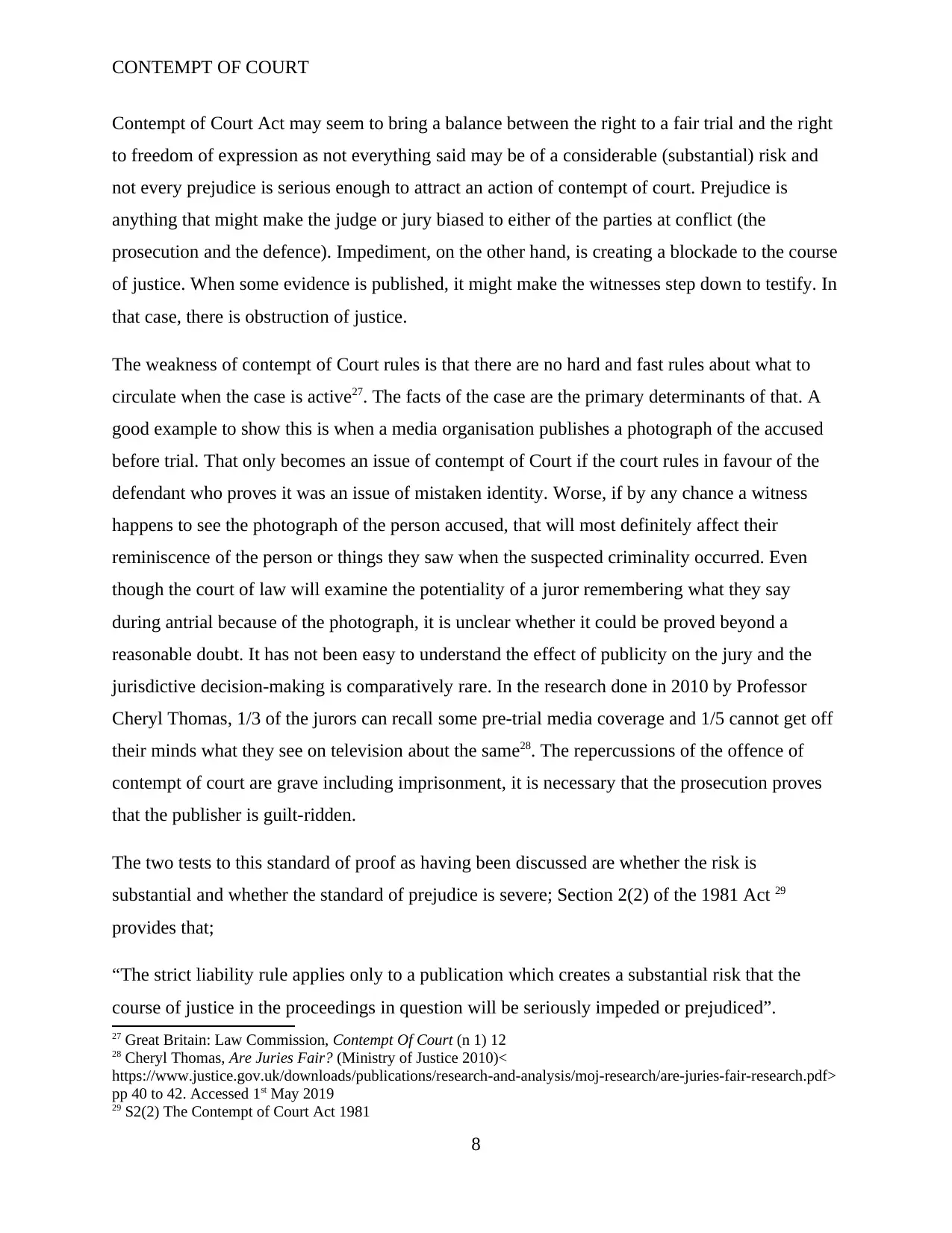
CONTEMPT OF COURT
Contempt of Court Act may seem to bring a balance between the right to a fair trial and the right
to freedom of expression as not everything said may be of a considerable (substantial) risk and
not every prejudice is serious enough to attract an action of contempt of court. Prejudice is
anything that might make the judge or jury biased to either of the parties at conflict (the
prosecution and the defence). Impediment, on the other hand, is creating a blockade to the course
of justice. When some evidence is published, it might make the witnesses step down to testify. In
that case, there is obstruction of justice.
The weakness of contempt of Court rules is that there are no hard and fast rules about what to
circulate when the case is active27. The facts of the case are the primary determinants of that. A
good example to show this is when a media organisation publishes a photograph of the accused
before trial. That only becomes an issue of contempt of Court if the court rules in favour of the
defendant who proves it was an issue of mistaken identity. Worse, if by any chance a witness
happens to see the photograph of the person accused, that will most definitely affect their
reminiscence of the person or things they saw when the suspected criminality occurred. Even
though the court of law will examine the potentiality of a juror remembering what they say
during antrial because of the photograph, it is unclear whether it could be proved beyond a
reasonable doubt. It has not been easy to understand the effect of publicity on the jury and the
jurisdictive decision-making is comparatively rare. In the research done in 2010 by Professor
Cheryl Thomas, 1/3 of the jurors can recall some pre-trial media coverage and 1/5 cannot get off
their minds what they see on television about the same28. The repercussions of the offence of
contempt of court are grave including imprisonment, it is necessary that the prosecution proves
that the publisher is guilt-ridden.
The two tests to this standard of proof as having been discussed are whether the risk is
substantial and whether the standard of prejudice is severe; Section 2(2) of the 1981 Act 29
provides that;
“The strict liability rule applies only to a publication which creates a substantial risk that the
course of justice in the proceedings in question will be seriously impeded or prejudiced”.
27 Great Britain: Law Commission, Contempt Of Court (n 1) 12
28 Cheryl Thomas, Are Juries Fair? (Ministry of Justice 2010)<
https://www.justice.gov.uk/downloads/publications/research-and-analysis/moj-research/are-juries-fair-research.pdf>
pp 40 to 42. Accessed 1st May 2019
29 S2(2) The Contempt of Court Act 1981
8
Contempt of Court Act may seem to bring a balance between the right to a fair trial and the right
to freedom of expression as not everything said may be of a considerable (substantial) risk and
not every prejudice is serious enough to attract an action of contempt of court. Prejudice is
anything that might make the judge or jury biased to either of the parties at conflict (the
prosecution and the defence). Impediment, on the other hand, is creating a blockade to the course
of justice. When some evidence is published, it might make the witnesses step down to testify. In
that case, there is obstruction of justice.
The weakness of contempt of Court rules is that there are no hard and fast rules about what to
circulate when the case is active27. The facts of the case are the primary determinants of that. A
good example to show this is when a media organisation publishes a photograph of the accused
before trial. That only becomes an issue of contempt of Court if the court rules in favour of the
defendant who proves it was an issue of mistaken identity. Worse, if by any chance a witness
happens to see the photograph of the person accused, that will most definitely affect their
reminiscence of the person or things they saw when the suspected criminality occurred. Even
though the court of law will examine the potentiality of a juror remembering what they say
during antrial because of the photograph, it is unclear whether it could be proved beyond a
reasonable doubt. It has not been easy to understand the effect of publicity on the jury and the
jurisdictive decision-making is comparatively rare. In the research done in 2010 by Professor
Cheryl Thomas, 1/3 of the jurors can recall some pre-trial media coverage and 1/5 cannot get off
their minds what they see on television about the same28. The repercussions of the offence of
contempt of court are grave including imprisonment, it is necessary that the prosecution proves
that the publisher is guilt-ridden.
The two tests to this standard of proof as having been discussed are whether the risk is
substantial and whether the standard of prejudice is severe; Section 2(2) of the 1981 Act 29
provides that;
“The strict liability rule applies only to a publication which creates a substantial risk that the
course of justice in the proceedings in question will be seriously impeded or prejudiced”.
27 Great Britain: Law Commission, Contempt Of Court (n 1) 12
28 Cheryl Thomas, Are Juries Fair? (Ministry of Justice 2010)<
https://www.justice.gov.uk/downloads/publications/research-and-analysis/moj-research/are-juries-fair-research.pdf>
pp 40 to 42. Accessed 1st May 2019
29 S2(2) The Contempt of Court Act 1981
8
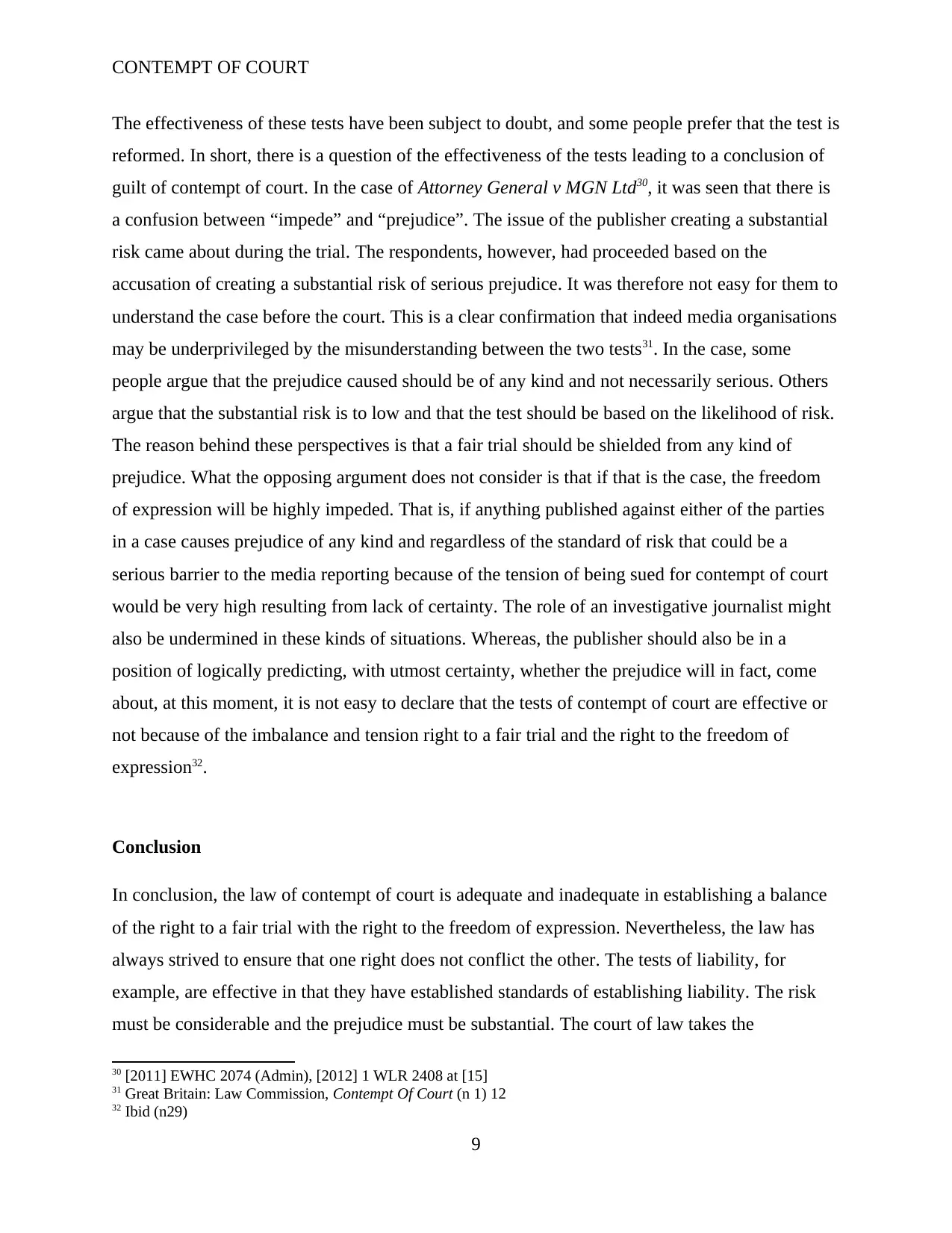
CONTEMPT OF COURT
The effectiveness of these tests have been subject to doubt, and some people prefer that the test is
reformed. In short, there is a question of the effectiveness of the tests leading to a conclusion of
guilt of contempt of court. In the case of Attorney General v MGN Ltd30, it was seen that there is
a confusion between “impede” and “prejudice”. The issue of the publisher creating a substantial
risk came about during the trial. The respondents, however, had proceeded based on the
accusation of creating a substantial risk of serious prejudice. It was therefore not easy for them to
understand the case before the court. This is a clear confirmation that indeed media organisations
may be underprivileged by the misunderstanding between the two tests31. In the case, some
people argue that the prejudice caused should be of any kind and not necessarily serious. Others
argue that the substantial risk is to low and that the test should be based on the likelihood of risk.
The reason behind these perspectives is that a fair trial should be shielded from any kind of
prejudice. What the opposing argument does not consider is that if that is the case, the freedom
of expression will be highly impeded. That is, if anything published against either of the parties
in a case causes prejudice of any kind and regardless of the standard of risk that could be a
serious barrier to the media reporting because of the tension of being sued for contempt of court
would be very high resulting from lack of certainty. The role of an investigative journalist might
also be undermined in these kinds of situations. Whereas, the publisher should also be in a
position of logically predicting, with utmost certainty, whether the prejudice will in fact, come
about, at this moment, it is not easy to declare that the tests of contempt of court are effective or
not because of the imbalance and tension right to a fair trial and the right to the freedom of
expression32.
Conclusion
In conclusion, the law of contempt of court is adequate and inadequate in establishing a balance
of the right to a fair trial with the right to the freedom of expression. Nevertheless, the law has
always strived to ensure that one right does not conflict the other. The tests of liability, for
example, are effective in that they have established standards of establishing liability. The risk
must be considerable and the prejudice must be substantial. The court of law takes the
30 [2011] EWHC 2074 (Admin), [2012] 1 WLR 2408 at [15]
31 Great Britain: Law Commission, Contempt Of Court (n 1) 12
32 Ibid (n29)
9
The effectiveness of these tests have been subject to doubt, and some people prefer that the test is
reformed. In short, there is a question of the effectiveness of the tests leading to a conclusion of
guilt of contempt of court. In the case of Attorney General v MGN Ltd30, it was seen that there is
a confusion between “impede” and “prejudice”. The issue of the publisher creating a substantial
risk came about during the trial. The respondents, however, had proceeded based on the
accusation of creating a substantial risk of serious prejudice. It was therefore not easy for them to
understand the case before the court. This is a clear confirmation that indeed media organisations
may be underprivileged by the misunderstanding between the two tests31. In the case, some
people argue that the prejudice caused should be of any kind and not necessarily serious. Others
argue that the substantial risk is to low and that the test should be based on the likelihood of risk.
The reason behind these perspectives is that a fair trial should be shielded from any kind of
prejudice. What the opposing argument does not consider is that if that is the case, the freedom
of expression will be highly impeded. That is, if anything published against either of the parties
in a case causes prejudice of any kind and regardless of the standard of risk that could be a
serious barrier to the media reporting because of the tension of being sued for contempt of court
would be very high resulting from lack of certainty. The role of an investigative journalist might
also be undermined in these kinds of situations. Whereas, the publisher should also be in a
position of logically predicting, with utmost certainty, whether the prejudice will in fact, come
about, at this moment, it is not easy to declare that the tests of contempt of court are effective or
not because of the imbalance and tension right to a fair trial and the right to the freedom of
expression32.
Conclusion
In conclusion, the law of contempt of court is adequate and inadequate in establishing a balance
of the right to a fair trial with the right to the freedom of expression. Nevertheless, the law has
always strived to ensure that one right does not conflict the other. The tests of liability, for
example, are effective in that they have established standards of establishing liability. The risk
must be considerable and the prejudice must be substantial. The court of law takes the
30 [2011] EWHC 2074 (Admin), [2012] 1 WLR 2408 at [15]
31 Great Britain: Law Commission, Contempt Of Court (n 1) 12
32 Ibid (n29)
9
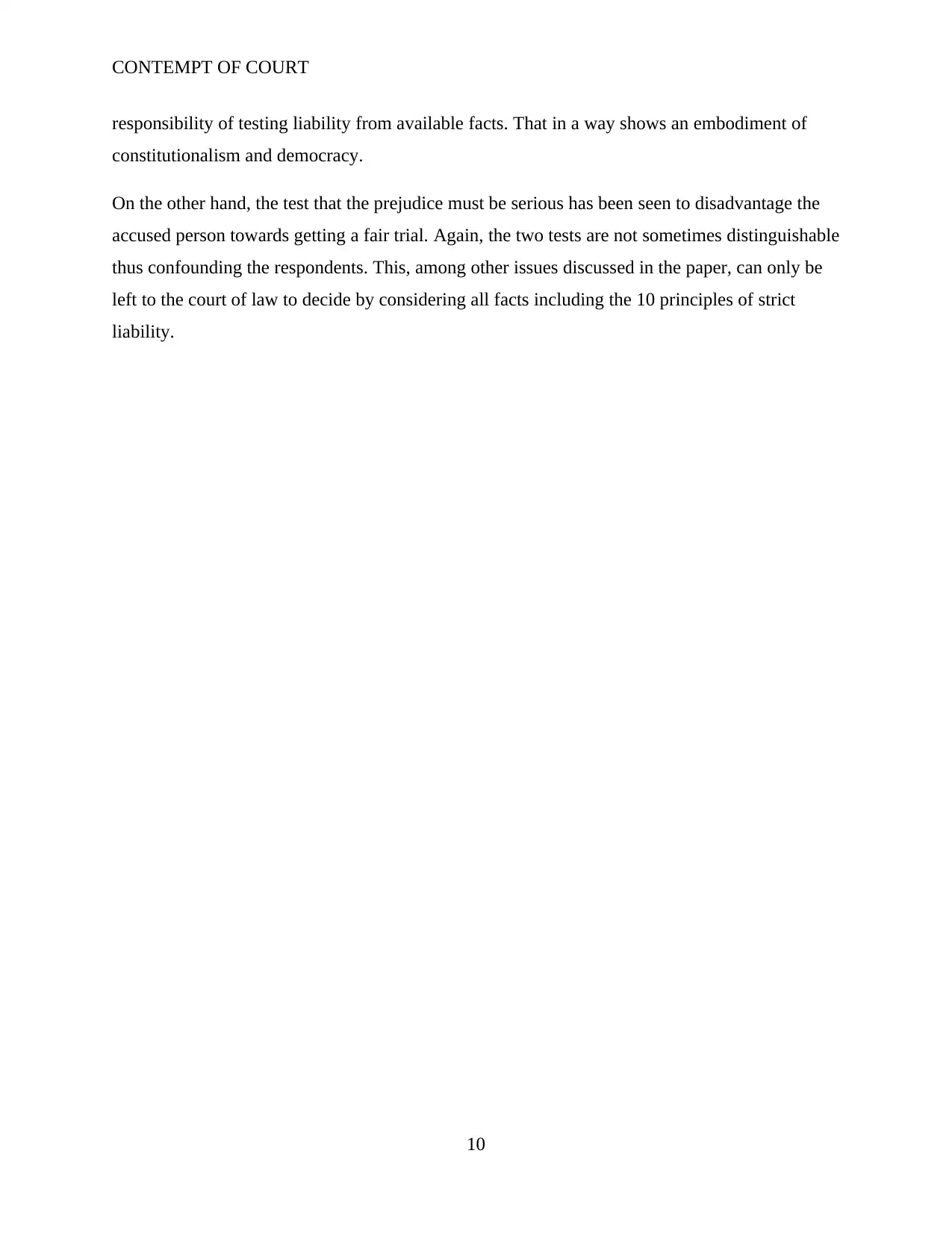
CONTEMPT OF COURT
responsibility of testing liability from available facts. That in a way shows an embodiment of
constitutionalism and democracy.
On the other hand, the test that the prejudice must be serious has been seen to disadvantage the
accused person towards getting a fair trial. Again, the two tests are not sometimes distinguishable
thus confounding the respondents. This, among other issues discussed in the paper, can only be
left to the court of law to decide by considering all facts including the 10 principles of strict
liability.
10
responsibility of testing liability from available facts. That in a way shows an embodiment of
constitutionalism and democracy.
On the other hand, the test that the prejudice must be serious has been seen to disadvantage the
accused person towards getting a fair trial. Again, the two tests are not sometimes distinguishable
thus confounding the respondents. This, among other issues discussed in the paper, can only be
left to the court of law to decide by considering all facts including the 10 principles of strict
liability.
10
Secure Best Marks with AI Grader
Need help grading? Try our AI Grader for instant feedback on your assignments.
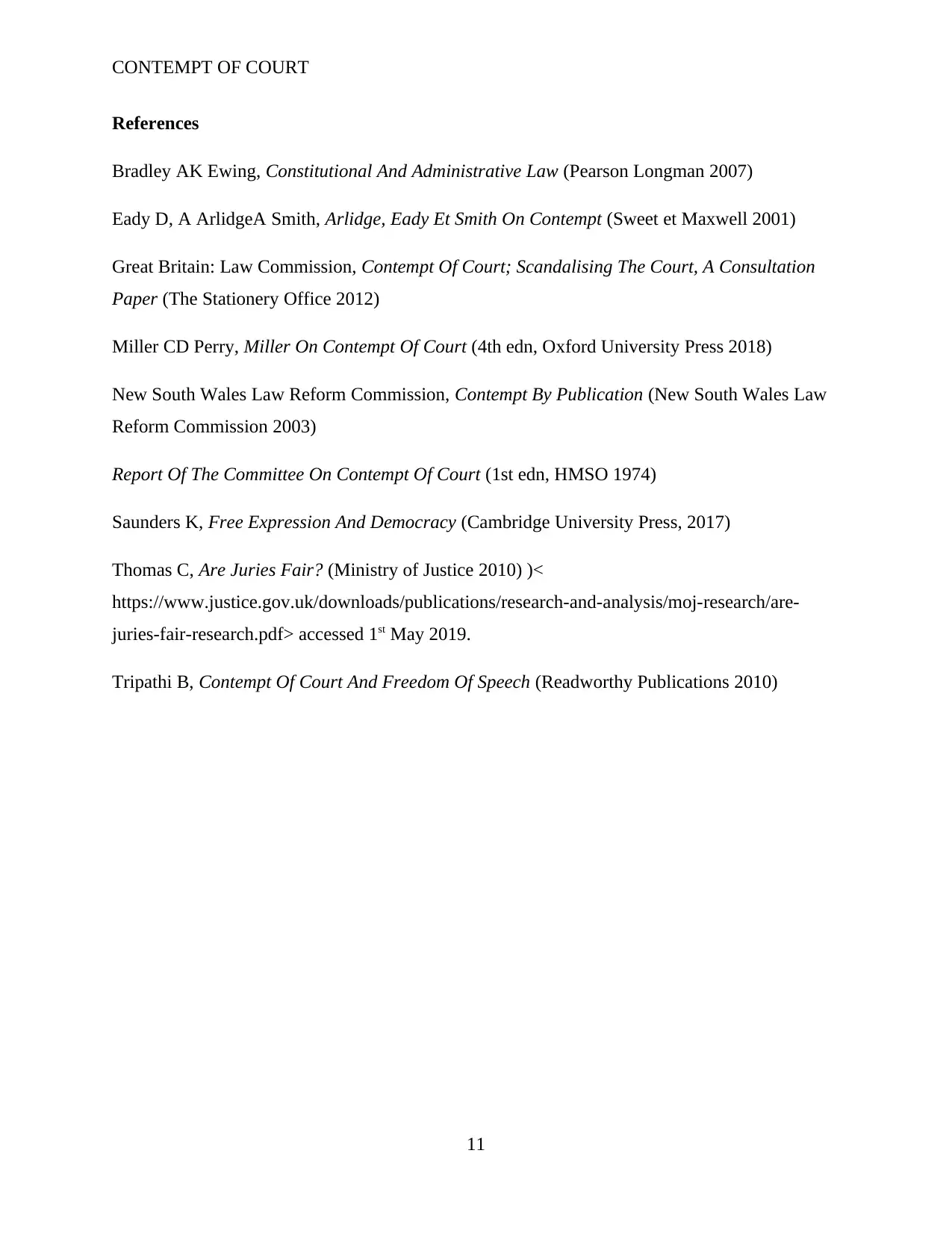
CONTEMPT OF COURT
References
Bradley AK Ewing, Constitutional And Administrative Law (Pearson Longman 2007)
Eady D, A ArlidgeA Smith, Arlidge, Eady Et Smith On Contempt (Sweet et Maxwell 2001)
Great Britain: Law Commission, Contempt Of Court; Scandalising The Court, A Consultation
Paper (The Stationery Office 2012)
Miller CD Perry, Miller On Contempt Of Court (4th edn, Oxford University Press 2018)
New South Wales Law Reform Commission, Contempt By Publication (New South Wales Law
Reform Commission 2003)
Report Of The Committee On Contempt Of Court (1st edn, HMSO 1974)
Saunders K, Free Expression And Democracy (Cambridge University Press, 2017)
Thomas C, Are Juries Fair? (Ministry of Justice 2010) )<
https://www.justice.gov.uk/downloads/publications/research-and-analysis/moj-research/are-
juries-fair-research.pdf> accessed 1st May 2019.
Tripathi B, Contempt Of Court And Freedom Of Speech (Readworthy Publications 2010)
11
References
Bradley AK Ewing, Constitutional And Administrative Law (Pearson Longman 2007)
Eady D, A ArlidgeA Smith, Arlidge, Eady Et Smith On Contempt (Sweet et Maxwell 2001)
Great Britain: Law Commission, Contempt Of Court; Scandalising The Court, A Consultation
Paper (The Stationery Office 2012)
Miller CD Perry, Miller On Contempt Of Court (4th edn, Oxford University Press 2018)
New South Wales Law Reform Commission, Contempt By Publication (New South Wales Law
Reform Commission 2003)
Report Of The Committee On Contempt Of Court (1st edn, HMSO 1974)
Saunders K, Free Expression And Democracy (Cambridge University Press, 2017)
Thomas C, Are Juries Fair? (Ministry of Justice 2010) )<
https://www.justice.gov.uk/downloads/publications/research-and-analysis/moj-research/are-
juries-fair-research.pdf> accessed 1st May 2019.
Tripathi B, Contempt Of Court And Freedom Of Speech (Readworthy Publications 2010)
11
1 out of 11
Your All-in-One AI-Powered Toolkit for Academic Success.
+13062052269
info@desklib.com
Available 24*7 on WhatsApp / Email
![[object Object]](/_next/static/media/star-bottom.7253800d.svg)
Unlock your academic potential
© 2024 | Zucol Services PVT LTD | All rights reserved.